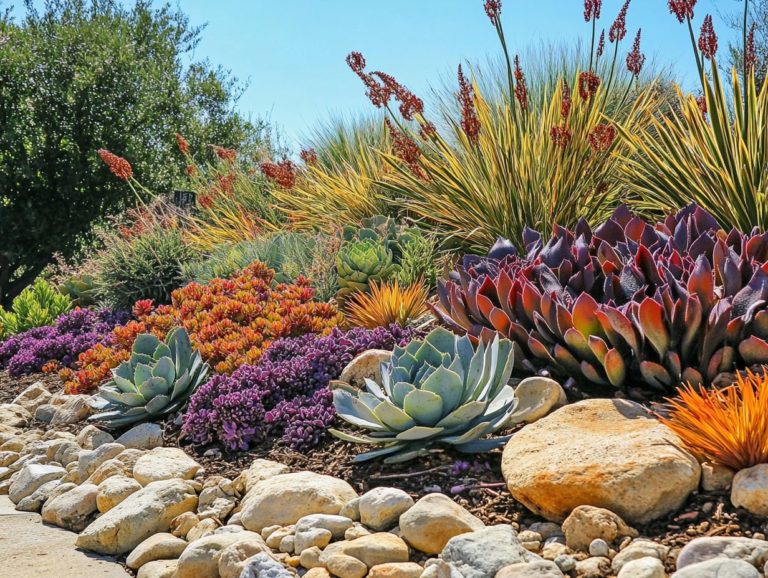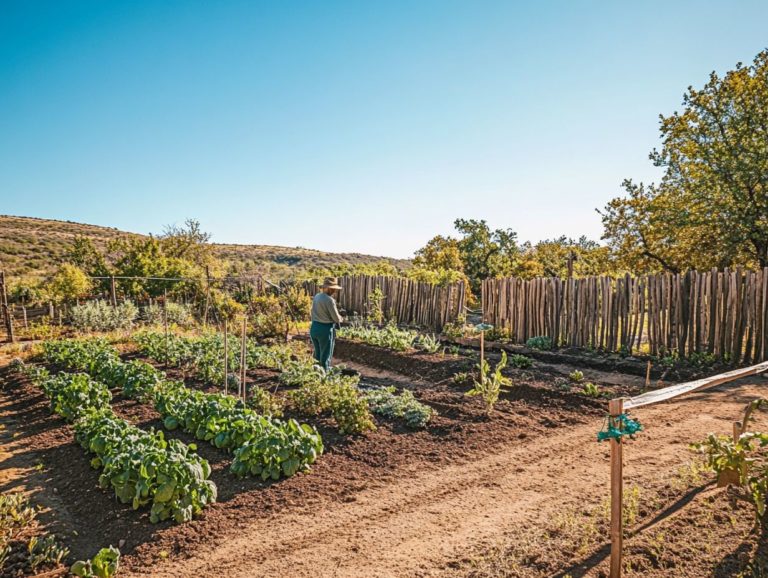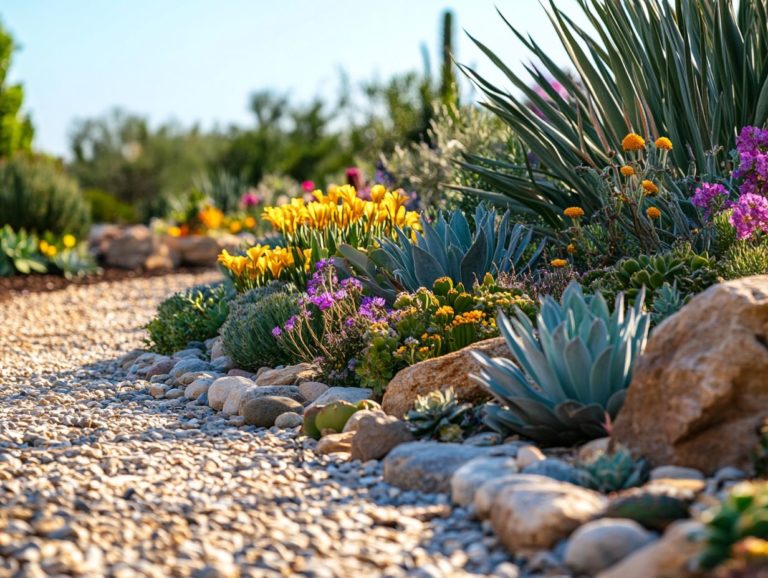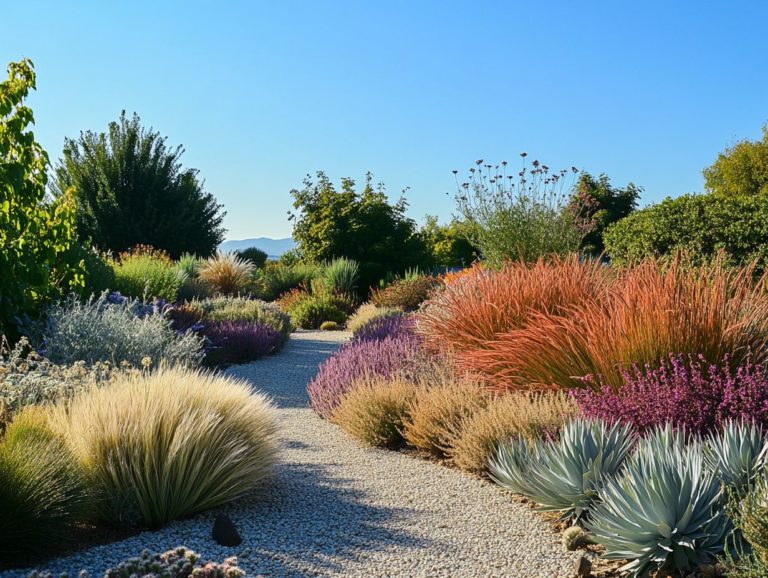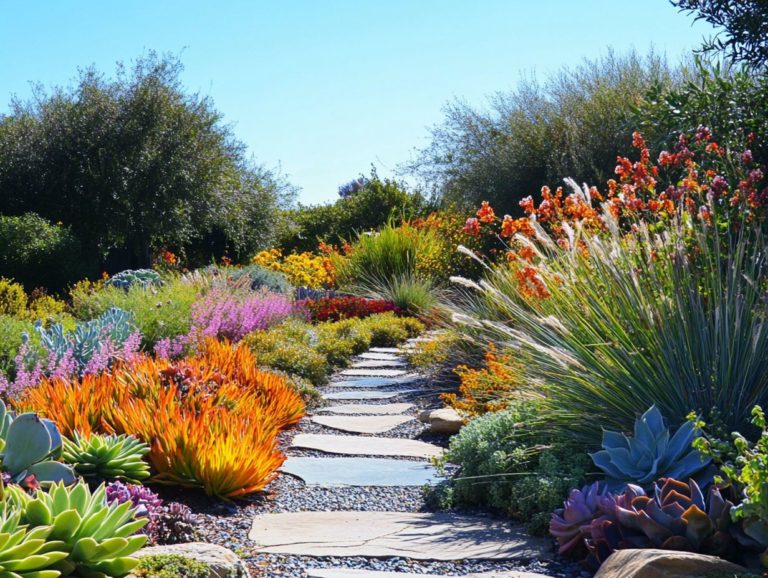Transforming Your Landscape for Drought
Drought significantly impacts landscapes. Homeowners in California, Arizona, and Nevada must understand its effects.
Drought influences water availability, the health of plants, soil conditions, and the overall aesthetic of your landscape. As temperatures rise and climatic conditions shift, communities must adapt landscaping practices, prioritizing sustainability and resource conservation.
Make informed choices to boost biodiversity. Create beautiful, drought-tolerant landscapes that thrive in tough conditions.
Contents
- Assessing Your Landscape for Drought
- Key Takeaways:
- Strategies for Transforming Your Landscape
- Maintaining Your Drought-Resistant Landscape
- Additional Tips for Drought-Proofing Your Landscape
- Frequently Asked Questions
- What does it mean to transform my landscape for drought?
- Why is it important to transform my landscape for drought?
- What features should I consider when transforming my landscape for drought?
- Can I still have a beautiful landscape while conserving water?
- Do I need to hire a professional to transform my landscape for drought?
- How often do I need to maintain my drought-resistant landscape?
Defining Drought and Its Causes
Drought is characterized by a prolonged period of abnormally low rainfall, resulting in water scarcity that profoundly affects ecosystems, agriculture, and various human activities.
This pressing issue has garnered increased attention due to its growing frequency, influenced by natural climate variations like El Ni o and La Ni a, as well as human-induced factors such as climate change. The U.S. Drought Monitor reports that California has endured over 300 documented drought events since the late 1800s, with the most severe episode from 2011 to 2017, leading to economic losses surpassing $2.7 billion.
Neighboring states have similarly grappled with these challenges. Agricultural sectors struggle with declining crop yields while water-intensive industries scramble for scarce resources. The insidious effects of drought infiltrate urban areas through escalating water costs and diminished recreational resources, ultimately affecting the quality of life for millions.
Assessing Your Landscape for Drought
Assessing your landscape for drought is crucial if you’re seeking to maintain your property while prioritizing water efficiency and sustainability.
By understanding the unique characteristics of your landscape and pinpointing vulnerable areas, you can implement effective strategies that conserve resources while enhancing the beauty of your outdoor space.
Evaluating the types of plants, soil conditions, and existing irrigation systems allows you to make informed decisions that support drought-resistant gardening practices, creating a thriving environment even in challenging climatic conditions.
Key Takeaways:
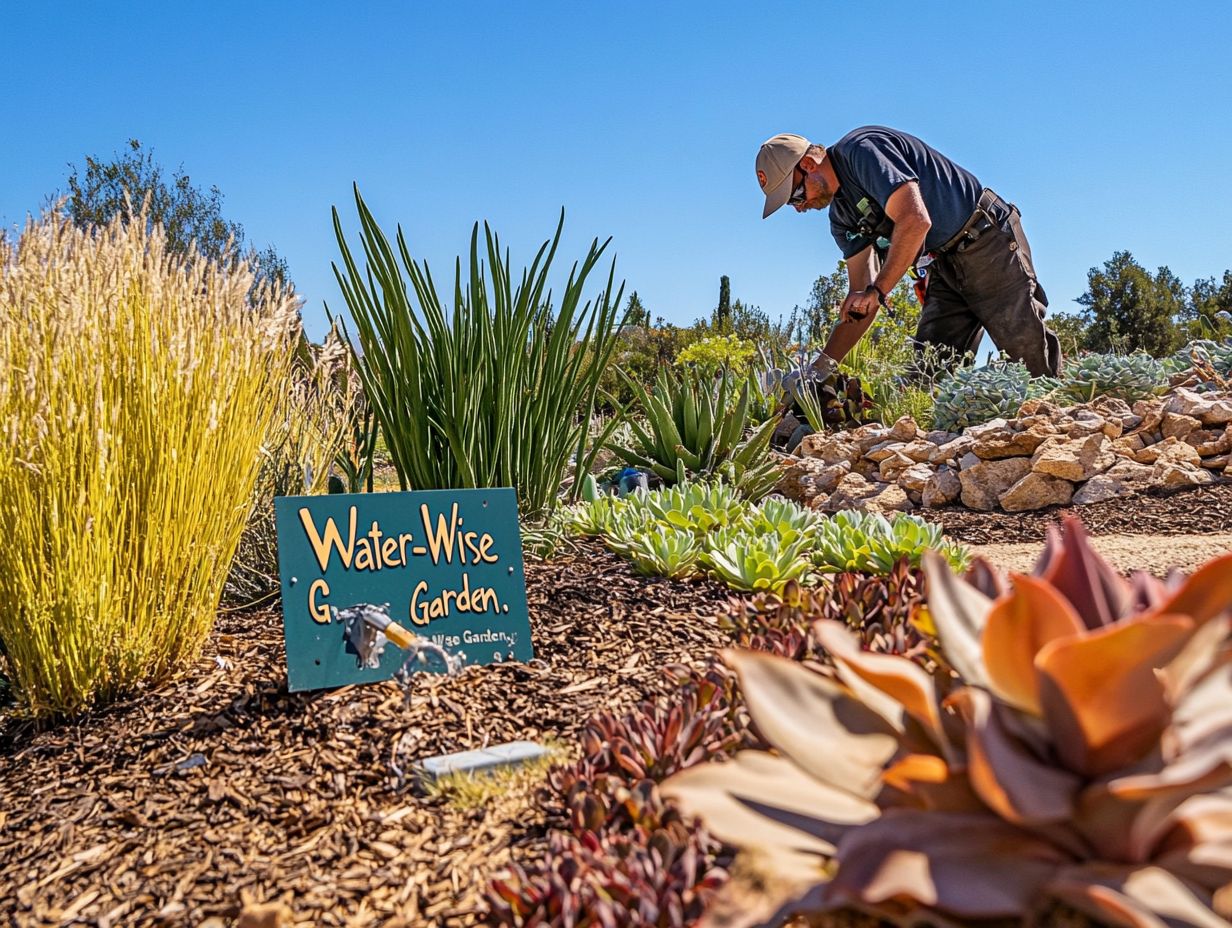
- Xeriscaping is a landscaping method that reduces or eliminates the need for irrigation, making your landscape more drought-resistant.
- Choosing drought-resistant plants can minimize drought’s impact and reduce maintenance needs.
- Effective watering is crucial for maintaining a sustainable landscape during drought.
Identifying Vulnerable Areas and Plants
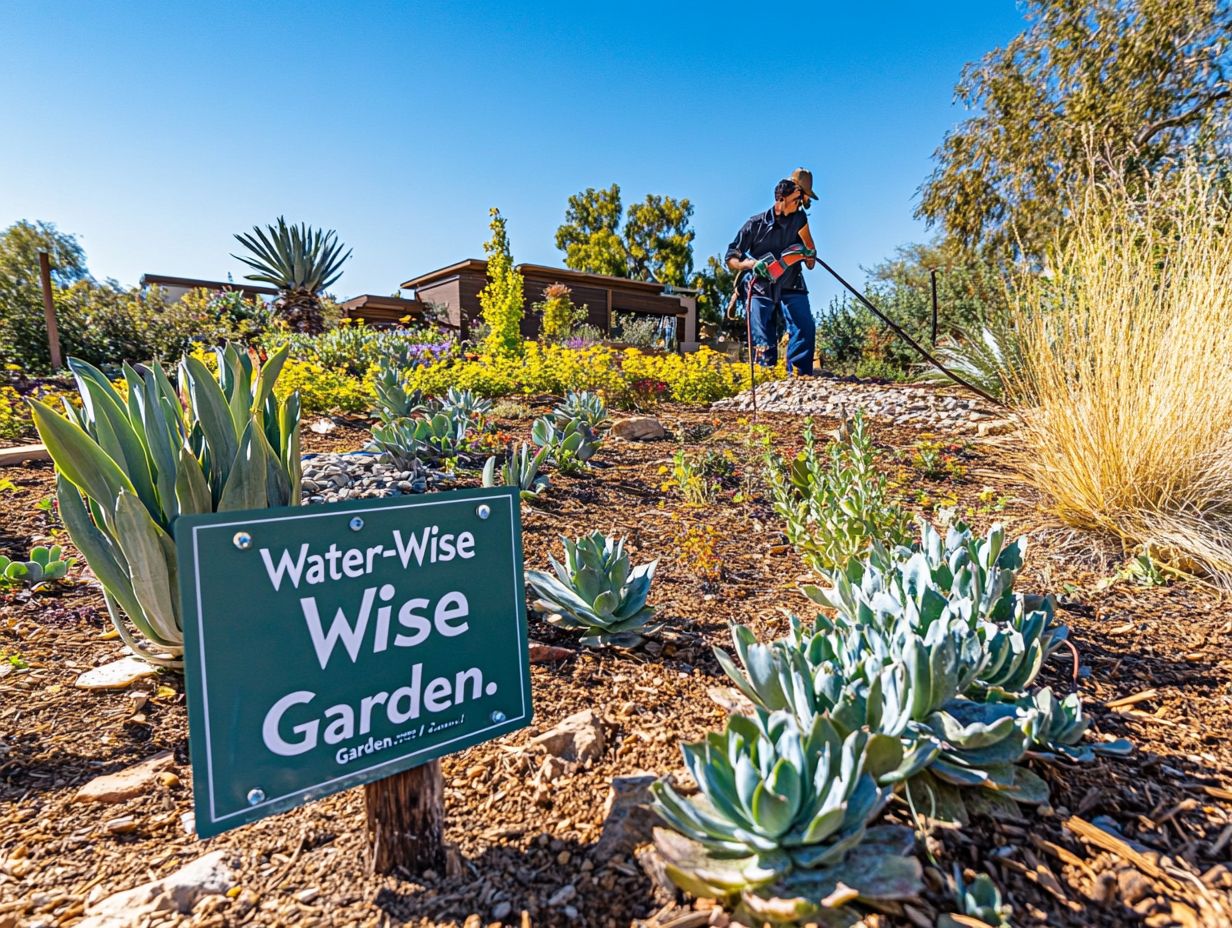
Identifying vulnerable areas and plants in your landscape is key to creating a drought-tolerant garden that thrives even in the face of water scarcity.
By keenly observing signs like wilting leaves, color change, or stunted growth, you can pinpoint which sections of your garden need a little extra love.
For example, incorporating native plants that survive with little water (drought-resistant plants) such as California Lilac, Matilija Poppy, and California Fuchsia not only elevates the visual appeal but also enhances your garden’s resilience against dry conditions.
These species are perfectly adapted to your local climate, significantly reducing the need for irrigation. By grouping plants according to their moisture requirements, you create a healthier ecosystem that minimizes competition for water resources, ensuring that each plant gets the care it truly deserves.
Strategies for Transforming Your Landscape
Transforming your landscape with smart design and xeriscaping techniques is key to creating a sustainable and drought-resistant environment that conserves water.
By embracing innovative landscaping practices tailored to your local climate, you can create outdoor spaces that enhance the beauty of your home and significantly contribute to water conservation and resource management.
Prioritizing the selection of drought-tolerant plants and implementing efficient irrigation systems will secure your long-term success while minimizing maintenance efforts and boosting biodiversity.
Xeriscaping Techniques
Xeriscaping is an innovative landscaping approach tailored to minimize or even eliminate the need for irrigation, employing efficient design principles and drought-resistant plants.
This sustainable method underscores the significance of soil management, focusing on enhancing soil health to effectively retain moisture and nutrients. You can choose native plants that flourish in your local climate, supporting biodiversity while keeping maintenance to a minimum.
Achieving efficient water use requires thoughtful planning, such as:
- Grouping plants with similar water needs together
- Incorporating mulch to shield the soil from erosion and evaporation
Communities that have embraced xeriscaping in their parks and public spaces often report reduced water consumption and lower maintenance costs, illustrating how this approach can yield both environmental and economic advantages.
Choosing Drought-Resistant Plants
Choosing plants that survive with little water is crucial for crafting a sustainable landscape that flourishes in arid conditions while conserving precious water resources.
By selecting native species that have adapted seamlessly to your local climate, you can cultivate vibrant outdoor spaces that require less water and simultaneously support local wildlife.
For instance, consider incorporating plants such as:
- Agave
- Red Yucca
- Desert Marigold
These choices bring a wealth of benefits. Not only do they enhance your landscape s aesthetic appeal with their striking shapes and colors, but they also promote resource efficiency through minimal maintenance requirements.
By grouping these species together, you can create captivating displays that attract pollinators and foster a robust ecosystem, ensuring your landscape is both stunning and environmentally responsible.
Maintaining Your Drought-Resistant Landscape
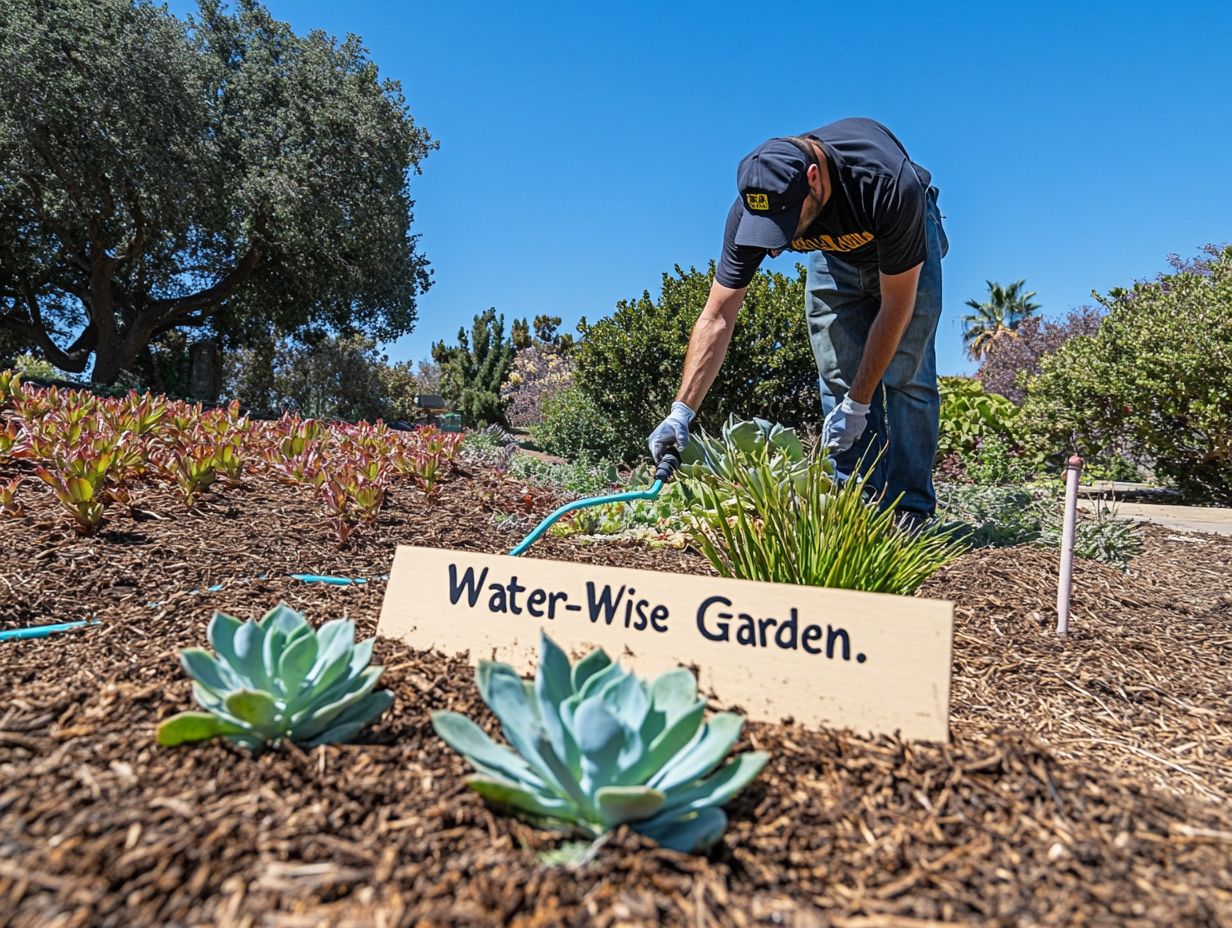
Maintaining your drought-resistant landscape demands a strategic approach to watering and care that harmonizes with sustainable practices. This ensures your plants not only survive but thrive, even in the face of challenging conditions.
Don t wait start implementing these tips today!
Start transforming your landscape today and help conserve our precious water resources!
Effective Watering and Maintenance Practices
Effective watering and maintenance practices are essential if you want a thriving garden, allowing you to retain the best moisture while conserving valuable water resources.
Implementing deep watering techniques enables water to penetrate deeply into the soil, encouraging roots to reach downwards where moisture is more stable. Utilizing mulch not only reduces evaporation but also improves soil health by preventing weed growth.
Smart watering systems play a vital role in making your landscape resilient; they are designed to provide the right amount of water at the most effective times, maximizing efficiency. Regular adjustments based on weather conditions, soil moisture levels, and plant types are essential to ensure these systems operate effectively, helping you maintain lush, green spaces with minimal waste.
Additional Tips for Drought-Proofing Your Landscape
Drought-proofing your landscape requires embracing various strategies and resources designed to optimize water conservation and foster sustainable practices, ensuring your gardening success for the long haul.
Conservation Methods and Resources
Exploring conservation methods and available resources is crucial for homeowners aiming to implement successful drought-resistant techniques in their landscapes.
By understanding sustainable landscaping practices, you can create environments that thrive under dry conditions and contribute to overall ecological health. Community resources offer workshops and educational materials that enable you to make informed decisions.
Local programs often provide practical guidance on selecting drought-resistant plants and smart watering techniques. Engaging with organizations and experts, like Sarah Finazzo, can enhance your knowledge, offering valuable insights into best practices and innovative solutions that benefit both your landscape and the broader community.
Frequently Asked Questions
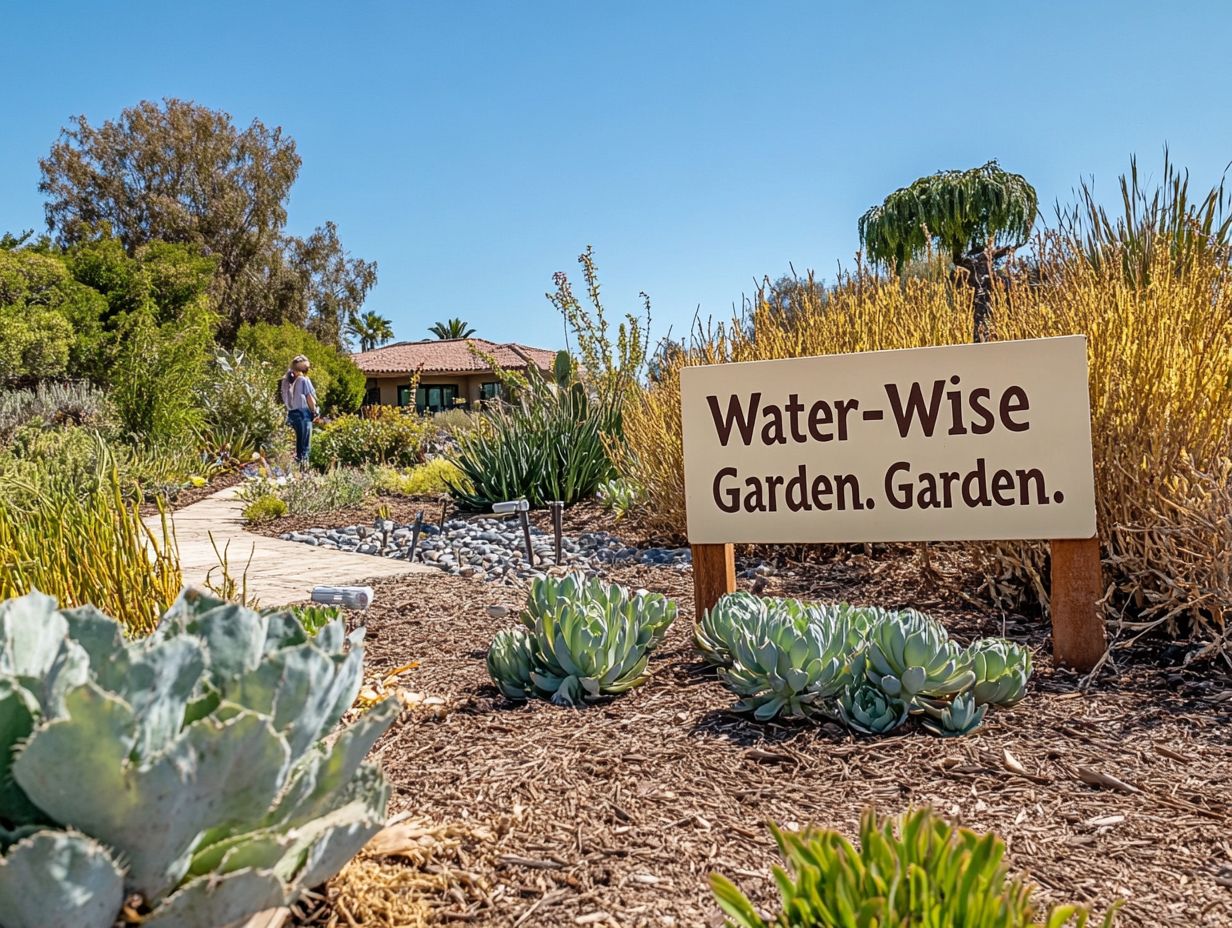
What does it mean to transform my landscape for drought?
Transforming your landscape for drought means making changes to conserve water and withstand dry periods. This includes choosing drought-resistant plants, installing irrigation systems, and implementing water-saving gardening techniques for drought.
Why is it important to transform my landscape for drought?
Droughts significantly impact the environment and our daily lives. By transforming your landscape for drought, you can conserve water, reduce strain on local water resources, and potentially save money on your water bill. Incorporating water features in drought-tolerant landscapes can further enhance your efforts.
What features should I consider when transforming my landscape for drought?
Transforming your landscape for drought can involve replacing grass with native plants in drought landscapes, installing drip irrigation systems, using mulch to retain moisture, and reducing lawn space.
Can I still have a beautiful landscape while conserving water?
Absolutely! Many beautiful plants and landscaping designs thrive in drought conditions. By choosing the right plants and using water-saving techniques, you can create a stunning and sustainable landscape.
Do I need to hire a professional to transform my landscape for drought?
While you can transform your landscape for drought on your own, consulting with a professional may be beneficial, especially for large or complex spaces. They can provide expert advice on using native plants in drought gardening and help you create a plan that fits your needs and budget.
How often do I need to maintain my drought-resistant landscape?
Drought-resistant landscapes typically require less maintenance than traditional ones, as they are designed to thrive in dry conditions. However, it’s important to regularly check and maintain your irrigation system, monitor plant health, and make adjustments as needed to ensure your landscape continues to thrive.

